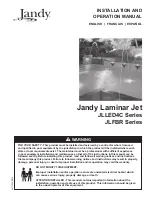
20
Relamping
The front cover is locked by springs, and has to be opened by
using a suction pad (Part. no 46500175) see also page 9.
The light tubes have to be removed from lamp holder by pull-
ing the tube straight out. (The lamp holder has no rotating part)
New light sources to be pushed straight into the fixing position
on lamp holders. The front cover is operating micro switch(es)
that switch off mains and battery voltage when the front cover
is removed from fix position. Re-lamping is thereby possible
without switching off the whole circuit.
Optional SelfTest
TX20 HF-E is also available with emergency Self Test System.
The Self Test fixture do have a bi-coloured LED indicating status
of the emergency system. The ballast/emergency unit will auto-
matically run a short monthly function test, and an annually full
discharge test operating the emergency lamp from the battery.
The test sequence will follow the IEC/EN 62034/2006.
“Automatic test System for battery powered escape light”.
There are five different statuses for the unit indicated by the
status LED as follows:
- Continious Green:
Everything OK
- Intermittent blinking Red: Lamp Error
- Continious blinking Red: Battery Capacity Error
- Continious Red:
Battery Charging Error
- No Light in LED:
No power or malfunction
of the emergency unit
Cables
Mains supply cable must be approved for fixed installation.
The external diameter should be 8 ® 13 mm (M20 gland) or
12 ® 19 mm (M25 gland). Cross sectional area of the wires
should be between 1.5 and 6.0 mm².
The cable must have an earth wire and a shielded cable is
recommended.
Operation of TX20 HF (without emergency light)
TX20 without battery back up do light when mains are
conected to N and L1. The fixture can be switched on/off by
switching the L1 conductor (1-pole switch), or by switching L1
and N (2-pole switch).
Operation of the TX20 HF-E (emergency light)
In emergency mode, one of the fixture tube is operating from
the battery, and is lighting with approximately 20% of the
normal light output.
When uninterrupted charging voltage is present (N and L4) the
charging indicater (green LED) is lighting up, indicating that
the battery is being charged. If the connection to the battery is
disrupted, the indicator will not light. A new or a discharged
battery must be charged for 24 hours to be fully charged. For
switching main light see connection diagram page 18.
Control
The function of the emergency light should be controlled at
least once a month. Full emergency test (switching off N, L1
and L4 to the luminaire) should be performed once a year and
the specified emergency lighting time should be observed
(1.5 or 3 hours for standard luminaire).
TX20 operation
Summary of Contents for aqua signal TX20 Series
Page 1: ...SERVICE MANUAL TX20 effective solutions for Ex Zones ...
Page 4: ...4 TX20 R PART NO C60052395 A B C D E ...
Page 5: ...5 TX20 R A ...
Page 6: ...6 TX20 R alternative suspension 0 70 mm 70 130 mm ...
Page 7: ...7 NB TX20 R B D ...
Page 8: ...8 TX20 R C C ...
Page 9: ...9 CLICK TX20 R ...
Page 14: ...14 TX20 S ...
Page 15: ...15 CLICK TX20 S ...
Page 19: ...19 ...





































